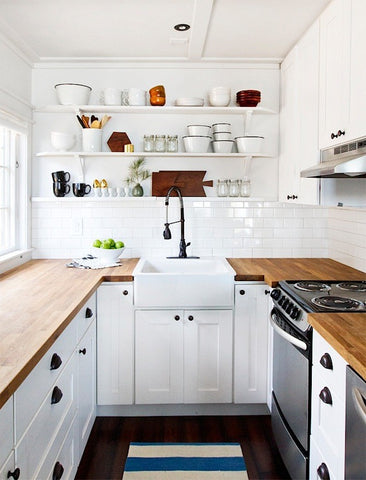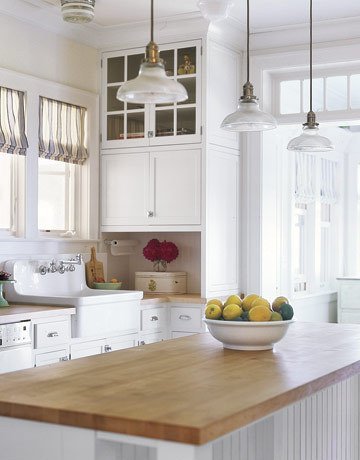Menu


Your Cart is Empty
September 10, 2015 3 min read
Wooden countertops have an unparalleled ability to add warmth to a kitchen. An affordable, durable option for this effect is butcher block. Butchers have used butcher block for centuries as a heavy duty chopping surface. In many European countries, butcher shops today still use them. Wood is not without drawback however and proper maintenance is required to keep these surfaces from dulling and cracking over time. Keep reading to find out if butcher block is right for you.

What is Butcher Block
Butcher block consists of straight cuts of wood glued together to produce a thick slab, perfect for a sturdy, stable work station. As wood, it is soft and porous; a surface that will develop nicks and scratches over its lifetime. This patina will contribute character to your home and lives, an attractive idea to some and not so much for others.
Styles
Edge grain is the one most commonly used for counters because it's strong, stable, and less expensive. It's made by placing long boards on their sides and joining them so that their long narrow edges form the surface. The boards can be continuous lengths of wood with no joints, or random-length boards that are finger-jointed (as shown above).
Flat-grain butcher block is constructed from boards that are laid flat, their full widths forming a surface with a streamlined look. Susceptible to marks when used for chopping and cutting, flat grain is less suitable for working kitchen counters than the others.
End-grain construction is made from small rectangular blocks arranged so that the ends (with growth rings showing) are visible on the surface. The strongest and most expensive type of butcher block, it's great for cutting surfaces, because it camouflages knife marks and is gentle on blade edge, sliding into the grain rather than against it.

What types of wood are used for butcher block?
While it can be put together from almost any wood, maple, as a hardwood with clear grain, is one of the best and most popular sources for butcher block counters. Cherry and red oak offer a richer color, as well as walnut. Butcher block can also be crafted from bamboo (it works best with end-grain construction) and other sustainably farmed exotics such as wenge and zebrawood.
Sealing & Maintenance
Sealed butcher block offers a shined wood surface that can go well as a desk or a workstation, but is not food or knife friendly due to the toxins in the sealant. If the surface is needed for food prep, the use of a cutting board is recommended. Food safe sealants are available, but are not as durable as regular sealants. Mark Squire of Quality Kitchen Cabinets in San Francisco explains: "Using sealed wood defeats the purpose of butcher block, because it covers up the natural warm surface with plastic."
Unsealed butcher block countertops should be oiled every six months or as needed to keep the wood protected. Different woods have different needs and it's best to follow the instructions of your installer. Surfaces that are heavily used may require more frequent oiling and conditioning to prevent the wood from cracking and looking dull. Avoid using cooking oil to treat butcher block and harsh, abrasive cleaners; they can damage the wood. Due to it’s soft nature, butcher block is easily marred—leading some people away from using it in the kitchen. Before oiling, you can lightly remove scratches, burns, and other surface damages with a fine grit sandpaper, making your counter new again.

Can butcher block be used as a cutting surface?
Yes, unsealed butcher block is historically a hard working surface. However a butcher block counter is not as easy to clean as a movable cutting board. Many homeowners still choose to use a cutting board on their butcher block counters. While it still requires proper cleaning, wood contains natural antibacterial and antimicrobial properties that make it an ideal food prep surface. Also, as mentioned, cutting on butcher block can lead to marks and scratches—character-defining to some, best avoided to others.
| Pros | Cons |
| It's a soft material that's easy on glassware and dishes | Wood counters are not heat or stain resistant: No hot pots & pans on the counter |
| Properly maintained, it is a durable choice | Wood can swell and shrink depending on humidity, which may lead to cracking |
| Repairable: Nicks and burns can be lightly sanded and the surface re-oiled | Excessive wetness may cause rot and discoloration |
| Develops a patina over time | Develops patina over time |
| Wood has natural antibacterial and antimicrobial properties | Some maintenance is required |







Comments will be approved before showing up.
Our goal is to provide you with as much information as possible. Our newsletter is full of tips, inspiration and featured projects. We promise to only send you interesting things and never share your email with anyone else.